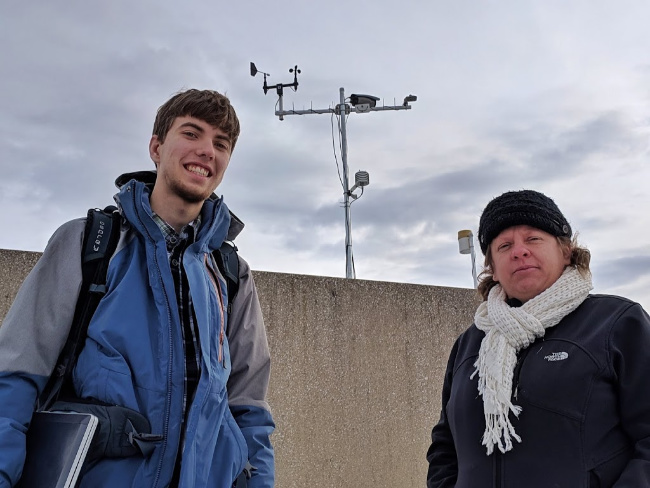
On a cold and blustery January morning, Shirley Papuga (right), an associate professor in Wayne State’s environmental science program, and environmental science student Alex Eklund (left) ascended the stairs to the roof of the Physics Building. Amidst the swirling snow showers and numbing cold, they checked on Wayne State’s first weather station. On this day, Weather@Wayne earned its keep.
“We really see this as a community resource and a key outreach tool,” said Papuga, who came to Wayne State 18 months ago from the University of Arizona in Tucson. “Weather@Wayne is instrumental in many campus projects that we can own.”
Weather@Wayne is part of the national Weather Underground network of weather stations located across the country. Many universities that offer environmental science and meteorology degrees are part of the network. Weather Underground provides weather data, forecasts and historical weather information. Weather@Wayne is funded jointly by the College of Liberal Arts and Sciences and the Office of the Vice President for Research. It transmits information automatically and requires no staffing.
Soon after arriving at Wayne State, Papuga saw a need for such a service. “We found that there were no weather stations in Detroit,” she said. “The closest one was in Windsor. To me, that represented a real void in the community.”

The station was instrumented in summer 2018 by students in WSU’s Department of Geology and Environmental Sciences Program. A wind vane, temperature and humidity probe, quantum radiation sensor and tipping bucket rain gauge were installed on the roof of the Physics Building. The station offers half-hourly and daily streams of meteorological data such as rainfall, wind speed and direction, air temperature and humidity, and incoming solar radiation.
Papuga’s work focuses on urban ecosystems and hydrology. “Weather@Wayne can help us project irrigation needs for urban agriculture and show how vegetation under the urban canopy is impacted by weather and climate. It’s a vital community resource.”
The station also captures real-time images of the city skyline using a camera that monitors vegetation change in Detroit’s urban forest — providing a metric for carbon accounting consistent with WSU’s Sustainability Strategic Plan.
The weather station is also valuable as a community resource. For instance, the campus weather station lies right along the Q-Line alignment. “Because weather conditions are an important consideration for the Q-Line to factor into its daily operations,” Papuga said. “We can provide important information to them every day.”
With the Detroit skyline visible under a hazy gray patina of winter cumuli, Eklund and Papuga checked the equipment on the roof. Eklund said the occasional operational glitches are still being ironed out, but for the most part the weather station works well. “It’s reliable and self-sufficient and provides an important service to the city of Detroit and the campus community,” he said.
Papuga pointed out that the weather station is an important outreach tool as well. “We recently had students from Cranbrook up to see the weather station,” she said. “They seemed really excited and asked a lot of good questions. So I see it as an important means to educate not only our students, but the community at large.”
It doesn’t hurt that the station can tweet out important, fundamental weather information. “It’s raining at Wayne State,” one recent tweet read. “Bring your umbrella.”
Follow on Twitter @WeatheratWayne for daily recaps, daily forecasts and alerts.
